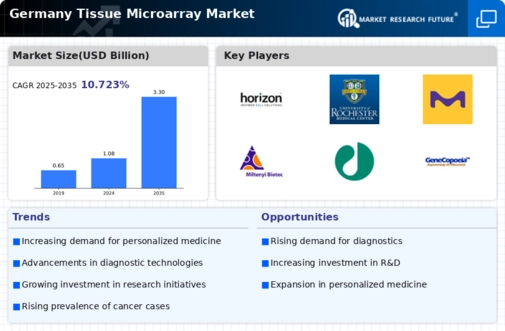Growth in Biobanking Initiatives
Germany's commitment to biobanking initiatives is fostering advancements in the tissue microarray market. Biobanks serve as repositories for biological samples, which are essential for research and development in personalized medicine. The availability of diverse tissue samples enhances the utility of tissue microarrays, enabling researchers to conduct comprehensive studies on disease mechanisms and treatment responses. As biobanking efforts expand, the tissue microarray market is likely to experience increased demand for its products. This growth is further supported by government funding aimed at enhancing biobanking infrastructure, which could lead to a more robust research environment and greater collaboration between institutions.
Rising Demand for Cancer Diagnostics
The increasing incidence of cancer in Germany is driving the demand for advanced diagnostic tools, including those in the tissue microarray market. As healthcare providers seek to enhance diagnostic accuracy, the adoption of tissue microarrays is likely to rise. According to recent data, cancer cases in Germany have surged, necessitating innovative solutions for early detection and treatment. The tissue microarray market is positioned to benefit from this trend, as these technologies allow for high-throughput analysis of tumor samples, facilitating personalized treatment plans. Furthermore, the integration of tissue microarrays in clinical settings is expected to improve patient outcomes, thereby reinforcing their importance in the healthcare landscape.
Emergence of Advanced Imaging Techniques
The integration of advanced imaging techniques in pathology is transforming the tissue microarray market. Innovations such as digital pathology and artificial intelligence are enhancing the analysis of tissue samples, allowing for more precise interpretations. In Germany, the adoption of these technologies is gaining momentum, as they offer significant improvements in efficiency and accuracy. The tissue microarray market stands to benefit from this trend, as researchers and clinicians increasingly rely on high-quality imaging to inform their decisions. The potential for improved diagnostic capabilities may lead to a broader acceptance of tissue microarrays in clinical practice, thereby expanding their market reach.
Collaboration Between Academia and Industry
The collaboration between academic institutions and industry players in Germany is fostering innovation within the tissue microarray market. These partnerships often lead to the development of cutting-edge technologies and methodologies that enhance the capabilities of tissue microarrays. By leveraging academic research and industry expertise, new applications and improvements are likely to emerge, driving market growth. Furthermore, such collaborations can facilitate access to funding and resources, enabling more extensive research projects. As the tissue microarray market continues to evolve, these partnerships may play a crucial role in shaping its future direction and expanding its impact on healthcare.
Regulatory Support for Innovative Diagnostics
The regulatory landscape in Germany is becoming increasingly supportive of innovative diagnostic solutions, including those in the tissue microarray market. Regulatory bodies are streamlining approval processes for new technologies, which may facilitate quicker market entry for tissue microarray products. This supportive environment encourages companies to invest in research and development, potentially leading to novel applications and improved product offerings. As regulatory frameworks evolve, the tissue microarray market could see a surge in innovation, ultimately benefiting healthcare providers and patients alike. The emphasis on regulatory compliance also ensures that products meet high standards of quality and efficacy.






















Leave a Comment